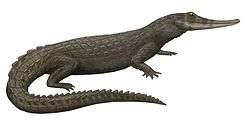Leiokarinosuchus
| Leiokarinosuchus Temporal range: Early Cretaceous | |
|---|---|
| Scientific classification | |
| Kingdom: | Animalia |
| Phylum: | Chordata |
| Class: | Reptilia |
| Superorder: | Crocodylomorpha |
| Clade: | Mesoeucrocodylia |
| Clade: | Metasuchia |
| Clade: | Neosuchia |
| Genus: | †Leiokarinosuchus Salisbury & Naish, 2011 |
| Type species | |
| †Leiokarinosuchus brookensis Salisbury & Naish, 2011 | |
Leiokarinosuchus (meaning "smooth-headed crocodile") is an extinct genus of neosuchian mesoeucrocodylian from the Early Cretaceous Wealden Group of southern England.[1][2] The type species Leiokarinosuchus brookensis was named in 2011 on the basis of a specimen that includes the back half of a skull, a few neck vertebrae, and some overlying osteoderms that make up the nuchal shield. It was first identified in 1887 by English naturalist Richard Lydekker as the remains of the pholidosaurid species Pholidosaurus meyeri, which is otherwise only known from Germany. Leiokarinosuchus differs from pholidosaurs in having bones of the skull roof and lower jaws with smooth surfaces. The smoothness of the lower jaw, along with the small size of the occipital condyle at the back of the skull, is a feature consistent with goniopholidids. However, Leiokarinosuchus differs from goniopholidids in the shape of its osteoderms, having angled surfaces and lacking forward-pointing articular processes. Another distinctive feature of Leiokarinosuchus is the inward sloping of the bones of the skull roof toward the supratemporal fenestrae.[3]
References
- ↑ Steven W. Salisbury and Darren Naish (2011). "Crocodilians". In Batten, D. J. (eds). English Wealden Fossils. The Palaeontological Association (London). pp. 305–369.
- ↑ Naish, Darren (2 December 2011). "The Wealden Bible: English Wealden Fossils, 2011". Tetrapod Zoology. Scientific American Blogs. Retrieved 5 December 2011.
- ↑ Naish, Darren (29 September 2012). "In pursuit of Early Cretaceous crocodyliforms in southern England (part II): of Vectisuchus and Leiokarinosuchus, Bernissartia and the hylaeochampsids". Tetrapod Zoology. Scientific American Blogs. Retrieved 29 September 2012.

